During the 2 July 2019, the main news agencies around the world circulated the news that an accident had involved a diving unit belonging to the Russian navy and that on board the submarine involved had registered victims. Some even went so far as to claim that the unit in question sank in a similar way to the August 12 2000 with the "K-141 Kursk" submarine.
Several days after the accident, and being able to count on better quality news, it is now possible to draw a different picture than the first frantic and fragmented news. However, it is necessary to state right now that the events that have taken place over the past few days show striking "shadow cones" that deserve to be analyzed in detail. First of all, the submarine affected by the accident is a sort of "legend" among the fans of the world of the abyss: the "Project 210 AS-12 Losharik" the last and most advanced "submarine-spy"Entered service with the Russian navy.
At the end of the "Cold War" and after having studied for years the successes achieved by the Americans in the field of "spy submarines" and for special uses, the Soviets decided to bridge the existing gap with the naval forces of their adversary countries by means of the introduction of new types of submarines. The first of these new classes was the "Project 1910 Kashalot" ("Uniform Class" according to the word NATO), the first true Soviet "spy submarines" dedicated. It is not clear how many have actually entered service since, originally, they were designed as a class of exemplary 3, but according to some sources they were made 2 (their identification code is not even certain since the names were proposed " AS-12 ”,“ AS-13 ”,“ AS-15 ”,“ AS-16 ”and“ AS-17 ”depending on the sources).
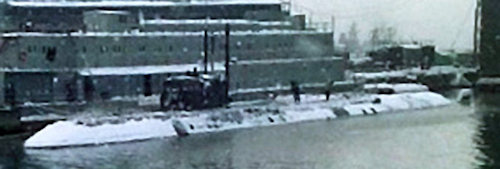
In any case, the introduction of these 2-3 submarines, starting with the 1986, has allowed the then Soviet navy to acquire considerable experience in the field of both underwater research and underwater espionage (after all, this type of unit is so flexible that it can be used both for military and scientific research operations) as well as preparing technical specifications for those who would later become their "successors".
The new submarines for espionage and scientific research arrived in the early '90 (when the Soviet Union no longer existed) in the form of the "Project 1851.1 X-Ray" class, built in a single copy, and in the "Project 1083.1 Paltus ”made instead in 2 specimens. Finally, the last "purchase" of the series was precisely the "AS-12 Losharik" (in the first photos), also made only in one specimen.
The types of missions formulated for this "flotilla" of 6-7 units ranged from the operations of pure and simple scientific research, to recognition towards selected strategic targets, to real operations in "James Bond 007" style against submarine cables located in NATO territorial waters.
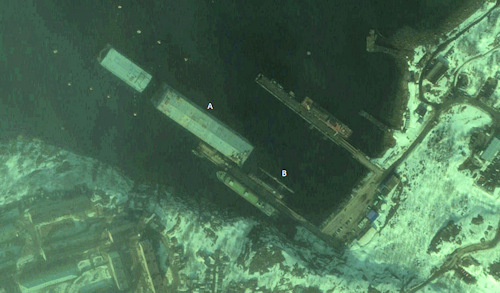 Given the confidential nature of the types of missions entrusted to submarines forming part of this particular "flotilla" it is not difficult to understand why the authorities have always remained "very buttoned up" about the performance, purpose and danger of such operations. Not only that, to protect the secrecy of these units, the Soviets first and then the Russians went so far as to create a special base used exclusively to serve the "flotilla" of spy submarines and their dedicated auxiliary vehicles. This base is located in Olenya Guba, a remote and forgotten place by God (even in a remote place like the extreme north of Russia!) With minimal infrastructure, among which, however, stands a huge "shed" literally positioned in the water, whose purpose is to host the "spy submarines" indoors and away from the prying eyes of the NATO rebirth satellites.
Given the confidential nature of the types of missions entrusted to submarines forming part of this particular "flotilla" it is not difficult to understand why the authorities have always remained "very buttoned up" about the performance, purpose and danger of such operations. Not only that, to protect the secrecy of these units, the Soviets first and then the Russians went so far as to create a special base used exclusively to serve the "flotilla" of spy submarines and their dedicated auxiliary vehicles. This base is located in Olenya Guba, a remote and forgotten place by God (even in a remote place like the extreme north of Russia!) With minimal infrastructure, among which, however, stands a huge "shed" literally positioned in the water, whose purpose is to host the "spy submarines" indoors and away from the prying eyes of the NATO rebirth satellites.
As stated before, the most mysterious of all these means is the "Losharik", set in the 1988, but entered into service only in the 2003 after a very long planning and construction process. Of the "Losharik" there are not even complete photos that show the hull in its entirety, only a few photographs that are quite blurred. What is known for sure, however, is that the hull was built using unconventional techniques; in fact the inner part of the same is divided into 7 "spheres" (and not in a single "corridor" as it is with all the other submarines of the world). The choice of this particular "arrangement" is due to the fact that the structure obtained is much more resistant both to pressure and to possible attacks by enemy vehicles, even if the narrow spaces thus obtained certainly do not help the liveability of the boat by of the crewmen. In any case, thanks to this ingenious invention, it seems that the "Losharik" is able to dive below 1000 meters (some sources even speak of 2000!) So the hull is able to withstand very high stresses.
As for the composition of the "crew sailors" then, there are plenty of surprises. Officially, in fact, the crew of the "Losharik" is made up of 25 men, which however can be increased in the case of particularly risky operations. One thing that impressed outside observers is the fact that among the 14 victims officially caused by the accident, 12 were captains and among them was the commander of the unit, Denis Dolonskiy. This confirms the previous rumors according to which the crew of the "Losharik" is composed solely of highly selected graduates and specialists.
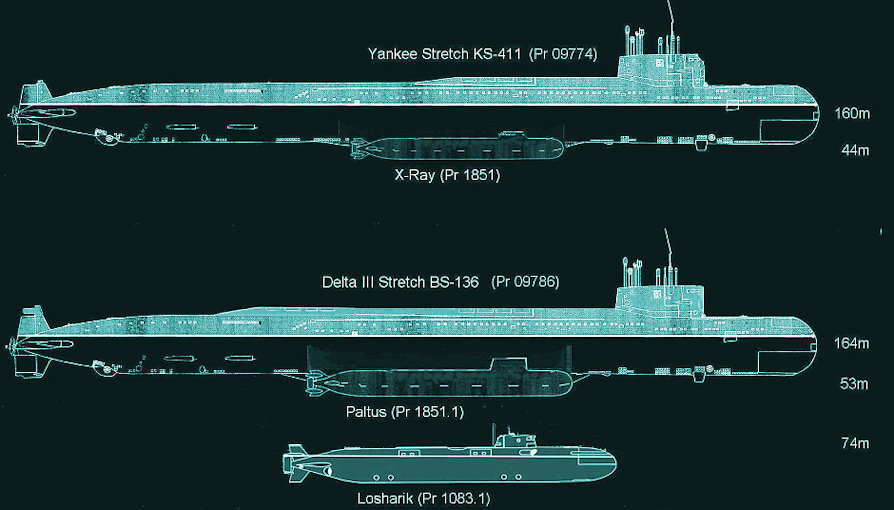
Another key feature when talking about the "Losharik" and its predecessors is the ability to deploy in the operational theater. In fact, while the 2-3 "Kashalot" are submarines of quite considerable dimensions, and therefore able to reach their goals on the high seas or on enemy coasts without having to rely on any help, the same is not true of the specimens smaller.
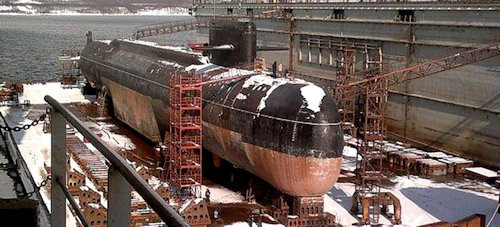
Both the "X-Ray" and the two "Paltus" that also the "Losharik", in fact, have too small dimensions to stay in the sea for a prolonged period of time, therefore they need the help of a bigger "submarine-mother" that literally "transports" the smallest "spy submarines" into the theater of operations and retrieves them later at the end of the operation (even if the "Losharik" would have the theoretical ability to complete even autonomous missions, even if not for too large a distance from the motherland and in any case not for excessively long periods of time).
The first of these submarines (now laid up in decommissioned and dismantled) was the "Yankee Stretch KS-411 Orenburg" obtained from an original "Yankee class" which was then extensively modified by removing the ballistic missile section and replacing it with a fairing designed to "accommodate" in the "belly of the hull" the smaller spy submarine in the same way as the "mother kangaroo" does.
Then came the introduction of the "BS-136 Orenburg" (previous photo) of the "Delta III class" and infinite of the "BS-64 Podmoskovye" of the "Delta IV class". Summing up then, the "flotilla" of the "spy submarines" available today to the Russian navy, all based in Olenya Guba, is composed of 1 submarine of the "X-Ray" class, 2 submarines of the "Paltus" class, 1 submarine of the class "Losharik" and 2 "submarines-mother" (the already mentioned "BS-136 Orenburg" and "BS-64 Podmoskovye") obtained through the conversion of 1 submarine ballistic missile launchers of the "Delta III class" and 1 submarine launcher missile ballistics of the "Delta IV class", while it seems that the 2-3 submarines of the "Kashalot class" have been laid up or in reserve.
 The tasks assigned to this "flotilla" concern both scientific research and military intelligence, in particular the positioning of instrumentation for listening to communications on cables belonging to the global submarine network. In the event of armed conflict, the "flotilla" could also carry out sabotage operations against underwater cables of particular strategic importance. And this fact brings us back to the dramatic 1 incident in July. According to the official reconstruction in fact, the fire broke out at 8.30 in the evening (Moscow time) starting from the battery compartment and was finally tamed by the crew at the price of heavy losses (including the aforementioned commander). Around the 9.30 (a circumstance confirmed by some local fishermen), the submarine emerged on the surface in the waters of the Ura bay and was then towed to the Severomorsk base (photo) by a Russian navy ship and two tugs. Once arrived in port, 5 seriously injured sailors would have been taken to the hospital while the operations of securing the reactor and the unit as a whole would have begun; operations that the Russian defense minister Sergey Shoigu would have announced as "Successfully completed" in the following three days.
The tasks assigned to this "flotilla" concern both scientific research and military intelligence, in particular the positioning of instrumentation for listening to communications on cables belonging to the global submarine network. In the event of armed conflict, the "flotilla" could also carry out sabotage operations against underwater cables of particular strategic importance. And this fact brings us back to the dramatic 1 incident in July. According to the official reconstruction in fact, the fire broke out at 8.30 in the evening (Moscow time) starting from the battery compartment and was finally tamed by the crew at the price of heavy losses (including the aforementioned commander). Around the 9.30 (a circumstance confirmed by some local fishermen), the submarine emerged on the surface in the waters of the Ura bay and was then towed to the Severomorsk base (photo) by a Russian navy ship and two tugs. Once arrived in port, 5 seriously injured sailors would have been taken to the hospital while the operations of securing the reactor and the unit as a whole would have begun; operations that the Russian defense minister Sergey Shoigu would have announced as "Successfully completed" in the following three days.
However, there are obvious inconsistencies in the official version presented by the Russian authorities:
- First: the fact that the "Losharik" has re-emerged at 9.30, a full hour after the start of the fire on board is simply nonsense. The security and risk containment procedures of submarine forces around the world provide that, in the event of an accident, the affected unit will immediately re-emerge to allow the eventual evacuation of the crew. Furthermore, it is much easier to fight a fire on board when on the surface than when you are diving;
- second: due to the death of 14 men and the serious injury of other 5, the 6 members still "able" would have had very serious difficulties managing a submarine of tonnage, however, quite important without receiving any kind of help, and this also taking into account that the "Losharik" is a medium characterized by high automation. Moreover, if it is true that, in order to contain the fire, the commander has isolated an entire section of the submarine, it is likely that the "surviving" sailors could not in any case have access to the whole vehicle;
- third: why were two tugs and a warship needed to tow a submarine that once emerged weighs 1600 tons (certainly not a "featherweight" but not even a "colossus")?
The author of this analysis was able to obtain 2 photographs taken in the Severomorsk base of the 3 in July in the mooring area reserved for submarines and, to great surprise, he was able to ascertain that the underwater unit therein is not the “AS -12 Losharik ", but one of the two" submarines-mother ", the" BS-64 Podmoskovye "! And this explains many things giving us the opportunity to formulate an alternative theory.
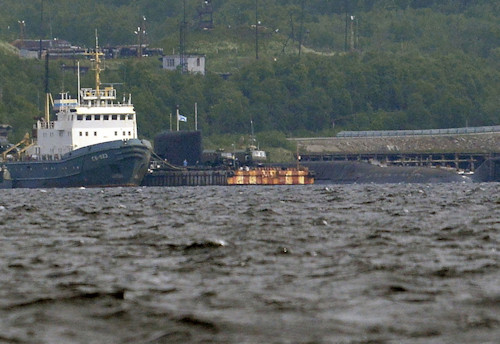 It is possible (here the condition is a must) that the "BS-64 Pormoskovye" was carrying the "AS-12 Losharik" hooked to the lower fairing for what should have been a long distance operation, probably in Norwegian waters (the bay of Ura where officially occurred the accident is located near the Norwegian territorial waters, to avoid misunderstandings). At some point, something must have gone wrong and a fire developed aboard the "spy submarine", a fire that the crews of the two submarines managed to tame despite the price of serious losses.
It is possible (here the condition is a must) that the "BS-64 Pormoskovye" was carrying the "AS-12 Losharik" hooked to the lower fairing for what should have been a long distance operation, probably in Norwegian waters (the bay of Ura where officially occurred the accident is located near the Norwegian territorial waters, to avoid misunderstandings). At some point, something must have gone wrong and a fire developed aboard the "spy submarine", a fire that the crews of the two submarines managed to tame despite the price of serious losses.
It is possible that, at the time of the accident, the "AS-12 Losharik" had recently detached from the "BS-64 Podmoskovye" and that everything had happened within the Norwegian territorial waters. In this delicate situation, the crew of the "Losharik" would have had to first sound the alarm to the brothers of the "Podmoskovye", then maneuver to hang up the two submarines and finally the two crews would have given battle to the fire bringing themselves back at the same time of Russian territorial waters where they could re-emerge and launch the SOS in command of the navy. This would explain the one-hour interval between the start of the fire and the emergence in the bay of Ura. At this point, even the use of three naval units to tow the unfortunates to the base would make sense given that the "BS-64 Podmoskovye" is a "beast" from 11.700 tons (not counting the "ballast" of the 1600 tons of " Russian submarine Losharik ").
As for the testimony of the fishermen, they probably simply reported having seen a submarine in difficulty, given that they are unlikely to have technical knowledge such as to recognize a submarine compared to another, especially if it is a secret unit like the "Russian submarine Losharik".
The emphasis with which Shoigu spoke of "making nuclear material safe" would be justified, given that the two submarines accommodated 3 nuclear reactors on the whole (2 of the VM4-SG model on the mother submarine and 1 of the E model -17 on the spy submarine). Finally this would also explain why the "Losharik" is not visible in the photographs anchored to Severomosk together with the "Podmoskovye"; the "spy submarine" would in fact still be hooked to the hull of the "submarine-mother" precisely to remove it from prying eyes. At the conclusion of this important examination of the "flotilla" of the Russian "spy submarines" and of the accident that occurred in recent days, we can say that:
- Russia has an important supply of submarines suitable for performing highly classified missions with a considerable potential impact;
- the incident showed that technical safety is never guaranteed to 100%, especially in prohibitive situations such as the depths of the oceans;
- the crews of the two submarines involved deserve praise anyway because, despite the price of serious losses, they managed to manage a complex and potentially catastrophic situation with extreme professionalism and spirit of sacrifice.
Photo: author / web / TASS












